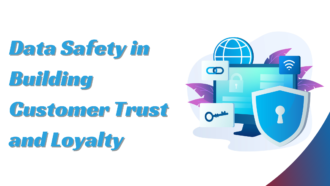Navigating the Digital Age: The Rise of Secure Online Workspaces
- 1 The Rise of Secure Online Workspaces
- 1.1 Embracing Strong Authentication Practices
- 1.2 Leveraging Virtual Data Rooms for Enhanced Security
- 1.3 Continuous Security Training and Awareness
- 1.4 Secure Collaboration Tools
- 1.5 Prioritising End-to-End Data Encryption
- 1.6 Charting the Course to Online Workspace Security
- 2 Conclusion:
- 2.1 FAQs
- 2.1.1 Is multi-factor authentication an effective method for securing online workspaces?
- 2.1.2 Are virtual data rooms solely for document storage?
- 2.1.3 Is continuous security training essential for maintaining a secure online workspace?
- 2.1.4 Does end-to-end data encryption ensure data integrity only during transmission?
In Short:
- Strong Authentication: Implement multi-factor authentication and educate employees on password security and phishing awareness.
- Virtual Data Rooms (VDRs): VDRs can be used for secure document storage, sharing, and collaboration, bolstering the integrity of sensitive projects.
- Continuous Education and Encryption: Prioritize ongoing security training, adopt secure collaboration tools, and prioritize end-to-end data encryption for comprehensive protection
In an era where the boundaries of office spaces have extended beyond the traditional confines to the vast expanse of the digital realm, the imperative for secure online workspaces has never been more critical. The surge in remote working arrangements, coupled with the escalating sophistication of cyber threats, has cast a spotlight on the urgency of fortifying digital domains. As organizations navigate the digital age, ensuring a secure online workspace is paramount to safeguarding sensitive information and fostering a trustworthy environment for employees. This discourse delves into strategies for enhancing security across online workspaces, paving the way for a safer, more resilient digital future for organizations.
The Rise of Secure Online Workspaces
Embracing Strong Authentication Practices
Robust authentication mechanisms are the foundation of a secure online workspace. Implementing multi-factor authentication (MFA) provides a critical barrier against unauthorized access. This method requires users to verify their identity through multiple pieces of evidence before gaining entry. This method significantly reduces the risk of security breaches from compromised credentials, ensuring only authorized personnel can access the online workspace.
Furthermore, employees must be educated on the importance of strong, unique passwords and the dangers of phishing attempts. Regular training sessions can heighten awareness and equip team members to recognize and react appropriately to potential security threats, reinforcing the organization’s defence against cyberattacks.
Leveraging Virtual Data Rooms for Enhanced Security
Virtual data rooms (VDRs) have emerged as a formidable tool for a secure online workspace. State-of-the-art VDR solutions are designed to provide a safe environment for storing and sharing sensitive documents, employing advanced security measures to protect against unauthorized access. Within VDRs, file tracking capabilities enable administrators to monitor document access, providing insights into who has viewed or modified files and when this activity occurred.
The utilization of VDRs extends beyond mere document storage; it facilitates secure collaboration among teams, regardless of their geographical locations. By offering a platform where sensitive projects can be managed with assurance, VDRs play a pivotal role in maintaining the security and integrity of the online workspace. This adoption of VDRs signifies a proactive approach to online workspace security, aligning with the evolving needs of modern organizations in safeguarding their digital assets.
Continuous Security Training and Awareness
A secure online workspace is not solely dependent on technological solutions; it hinges on its users’ continuous education and awareness. Organizations must invest in security training programs to keep employees abreast of the latest cyber threats and preventive measures. These programs should cover secure browsing
practices, recognizing phishing emails, and properly handling sensitive information. Empowering employees with this knowledge turns them into an active line of defence against cyber threats, significantly reducing the risk of security breaches.
Regular security drills and simulations can further reinforce this education, testing employees’ responses to simulated attacks and identifying areas for improvement. This proactive approach to security awareness ensures that the organization’s human resources are well-prepared to contribute to the overall security of the online workspace.
Secure Collaboration Tools
Adopting secure collaboration tools is vital to enhancing the security of online workspaces. Tools that offer end-to-end encryption for messaging, video conferencing, and document sharing are essential for protecting an organization’s integrity of communication and collaboration. These tools should also provide features like access controls and audit logs, enabling administrators to regulate and monitor the flow of information.
Selecting collaboration tools that comply with industry standards and regulatory requirements ensures that organizations can collaborate effectively without compromising security. As remote work continues to grow, the importance of these secure collaboration tools in maintaining a cohesive and protected online workspace cannot be overstated.
Prioritising End-to-End Data Encryption
Organizations must prioritize data encryption at rest and in transit to navigate the digital age safely. End-to-end encryption ensures that information is converted into a secure format from when it is sent until it reaches its intended recipient, rendering it unreadable to any third parties who might intercept it. This level of security is crucial for protecting sensitive data from cyber threats and maintaining the confidentiality of corporate communications.
Investing in encryption technologies fortifies an organization’s data integrity and builds trust among employees and clients. By demonstrating a commitment to data security, organizations can foster a culture of confidence and reliability, which is indispensable in the digital age.
Charting the Course to Online Workspace Security
Navigating the digital age demands a multifaceted approach to securing online workspaces, where technology, education, collaboration, and culture converge to protect the digital footprints of businesses, non-profits, and academic institutions. By embracing these strategies, organizations can fortify their defences against the sophisticated landscape of cyber threats, ensuring their digital assets’ confidentiality, integrity, and availability. The rise of secure online workspaces marks a new frontier in data security, where innovation and vigilance go hand in hand to chart the course toward a safer digital future.
Conclusion:
In today’s digital landscape, organizations must ensure secure online workspaces. By implementing robust authentication methods, leveraging virtual data rooms, prioritizing continuous education, and embracing encryption technologies, businesses can fortify their defences against cyber threats and pave the way for a safer digital future.
FAQs
Is multi-factor authentication an effective method for securing online workspaces?
True. Multi-factor authentication adds an extra layer of security by requiring users to provide multiple forms of identification.
Are virtual data rooms solely for document storage?
False. Virtual data rooms also facilitate secure collaboration among teams, regardless of geographical locations.
Is continuous security training essential for maintaining a secure online workspace?
True. Continuous security training keeps employees informed about the latest cyber threats and preventive measures, empowering them to contribute to the organization’s security efforts.
Does end-to-end data encryption ensure data integrity only during transmission?
False. End-to-end data encryption ensures data integrity both at rest and in transit, protecting sensitive information from unauthorized access at all times.


















